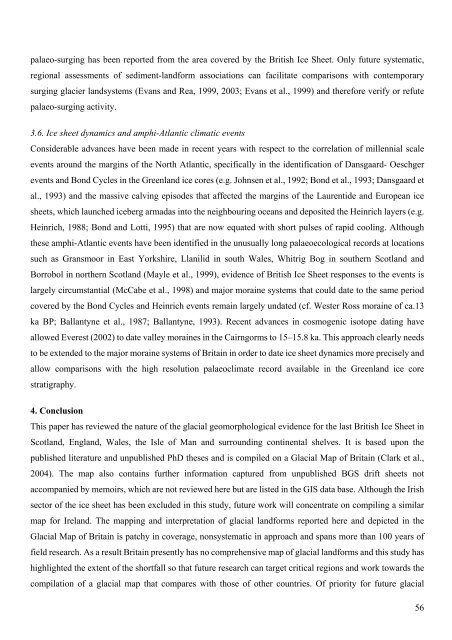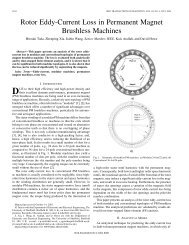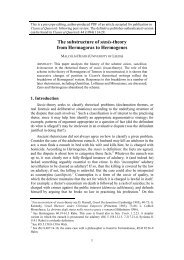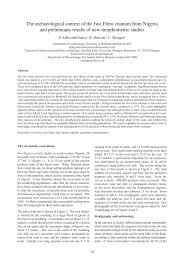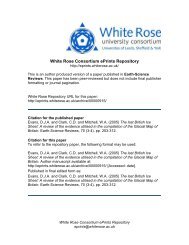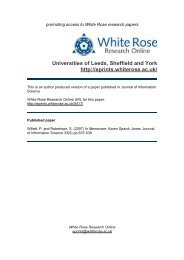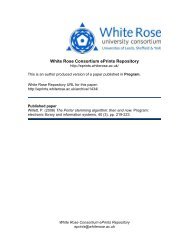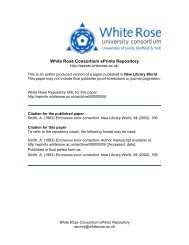The last British Ice Sheet: A review of the evidence utilised in the ...
The last British Ice Sheet: A review of the evidence utilised in the ...
The last British Ice Sheet: A review of the evidence utilised in the ...
Create successful ePaper yourself
Turn your PDF publications into a flip-book with our unique Google optimized e-Paper software.
palaeo-surg<strong>in</strong>g has been reported from <strong>the</strong> area covered by <strong>the</strong> <strong>British</strong> <strong>Ice</strong> <strong>Sheet</strong>. Only future systematic,<br />
regional assessments <strong>of</strong> sediment-landform associations can facilitate comparisons with contemporary<br />
surg<strong>in</strong>g glacier landsystems (Evans and Rea, 1999, 2003; Evans et al., 1999) and <strong>the</strong>refore verify or refute<br />
palaeo-surg<strong>in</strong>g activity.<br />
3.6. <strong>Ice</strong> sheet dynamics and amphi-Atlantic climatic events<br />
Considerable advances have been made <strong>in</strong> recent years with respect to <strong>the</strong> correlation <strong>of</strong> millennial scale<br />
events around <strong>the</strong> marg<strong>in</strong>s <strong>of</strong> <strong>the</strong> North Atlantic, specifically <strong>in</strong> <strong>the</strong> identification <strong>of</strong> Dansgaard- Oeschger<br />
events and Bond Cycles <strong>in</strong> <strong>the</strong> Greenland ice cores (e.g. Johnsen et al., 1992; Bond et al., 1993; Dansgaard et<br />
al., 1993) and <strong>the</strong> massive calv<strong>in</strong>g episodes that affected <strong>the</strong> marg<strong>in</strong>s <strong>of</strong> <strong>the</strong> Laurentide and European ice<br />
sheets, which launched iceberg armadas <strong>in</strong>to <strong>the</strong> neighbour<strong>in</strong>g oceans and deposited <strong>the</strong> He<strong>in</strong>rich layers (e.g.<br />
He<strong>in</strong>rich, 1988; Bond and Lotti, 1995) that are now equated with short pulses <strong>of</strong> rapid cool<strong>in</strong>g. Although<br />
<strong>the</strong>se amphi-Atlantic events have been identified <strong>in</strong> <strong>the</strong> unusually long palaeoecological records at locations<br />
such as Gransmoor <strong>in</strong> East Yorkshire, Llanilid <strong>in</strong> south Wales, Whitrig Bog <strong>in</strong> sou<strong>the</strong>rn Scotland and<br />
Borrobol <strong>in</strong> nor<strong>the</strong>rn Scotland (Mayle et al., 1999), <strong>evidence</strong> <strong>of</strong> <strong>British</strong> <strong>Ice</strong> <strong>Sheet</strong> responses to <strong>the</strong> events is<br />
largely circumstantial (McCabe et al., 1998) and major mora<strong>in</strong>e systems that could date to <strong>the</strong> same period<br />
covered by <strong>the</strong> Bond Cycles and He<strong>in</strong>rich events rema<strong>in</strong> largely undated (cf. Wester Ross mora<strong>in</strong>e <strong>of</strong> ca.13<br />
ka BP; Ballantyne et al., 1987; Ballantyne, 1993). Recent advances <strong>in</strong> cosmogenic isotope dat<strong>in</strong>g have<br />
allowed Everest (2002) to date valley mora<strong>in</strong>es <strong>in</strong> <strong>the</strong> Cairngorms to 15–15.8 ka. This approach clearly needs<br />
to be extended to <strong>the</strong> major mora<strong>in</strong>e systems <strong>of</strong> Brita<strong>in</strong> <strong>in</strong> order to date ice sheet dynamics more precisely and<br />
allow comparisons with <strong>the</strong> high resolution palaeoclimate record available <strong>in</strong> <strong>the</strong> Greenland ice core<br />
stratigraphy.<br />
4. Conclusion<br />
This paper has <strong>review</strong>ed <strong>the</strong> nature <strong>of</strong> <strong>the</strong> glacial geomorphological <strong>evidence</strong> for <strong>the</strong> <strong>last</strong> <strong>British</strong> <strong>Ice</strong> <strong>Sheet</strong> <strong>in</strong><br />
Scotland, England, Wales, <strong>the</strong> Isle <strong>of</strong> Man and surround<strong>in</strong>g cont<strong>in</strong>ental shelves. It is based upon <strong>the</strong><br />
published literature and unpublished PhD <strong>the</strong>ses and is compiled on a Glacial Map <strong>of</strong> Brita<strong>in</strong> (Clark et al.,<br />
2004). <strong>The</strong> map also conta<strong>in</strong>s fur<strong>the</strong>r <strong>in</strong>formation captured from unpublished BGS drift sheets not<br />
accompanied by memoirs, which are not <strong>review</strong>ed here but are listed <strong>in</strong> <strong>the</strong> GIS data base. Although <strong>the</strong> Irish<br />
sector <strong>of</strong> <strong>the</strong> ice sheet has been excluded <strong>in</strong> this study, future work will concentrate on compil<strong>in</strong>g a similar<br />
map for Ireland. <strong>The</strong> mapp<strong>in</strong>g and <strong>in</strong>terpretation <strong>of</strong> glacial landforms reported here and depicted <strong>in</strong> <strong>the</strong><br />
Glacial Map <strong>of</strong> Brita<strong>in</strong> is patchy <strong>in</strong> coverage, nonsystematic <strong>in</strong> approach and spans more than 100 years <strong>of</strong><br />
field research. As a result Brita<strong>in</strong> presently has no comprehensive map <strong>of</strong> glacial landforms and this study has<br />
highlighted <strong>the</strong> extent <strong>of</strong> <strong>the</strong> shortfall so that future research can target critical regions and work towards <strong>the</strong><br />
compilation <strong>of</strong> a glacial map that compares with those <strong>of</strong> o<strong>the</strong>r countries. Of priority for future glacial<br />
56


